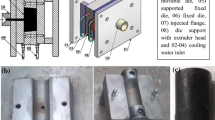Abstract
The purpose of the study is to elucidate fiber deformation behavior during the forging of a spur gear by using a carbon fiber reinforced thermoplastic billet. The billet was composed of PA6/UD chips with a fiber length of 30 mm and fiber volume fraction of 50%. A gear forging mold was developed to deform the billet into a gear shape without cutting the fibers. Three types of billets were prepared: a horizontal billet with fibers orientated in the X and the Y directions, a vertical billet with fibers orientated in the Z and the X directions, and a random billet with fibers randomly orientated in the X–Y plane. The fibers along the tooth profile were formed using the horizontal and vertical billets. The adjacent teeth were connected by the fibers. A maximum tooth bending strength was 500 MPa. The delamination occurred under the tooth valley. The orientation of fibers in the teeth using the random billet was also random. The fracture occurred in the middle of the tooth. The results indicated that the fiber orientation in the billet is strongly correlated to the fiber orientation in the gear teeth and the tooth strength. The fiber orientation in the billet proposed in the study can form a tooth with fibers along its profile and with high strength.


























Similar content being viewed by others
Data availability
Not applicable.
References
Mao K, Greenwood D, Ramakrishnan R, Goodship V, Shrouti C, Chetwynd D, Langlois P (2019) The wear resistance improvement of fibre reinforced polymer composite gears. Wear. 426–427:1033–1039
Senthilvelan S, Gnanamoorthy R (2004) Damage mechanisms in injection molded unreinforced, glass and carbon reinforced nylon 66 spur gears. Appl. Compos. Mater. 11(6):377–397
Sharma, A., Aggarwal, ML., Singh, L. (2017). Experimental investigation into the effect of noise and damping using composite spur gear. Proceedings of ICMPC 2016, pp. 2777–82. Available from: https://www.sciencedirect.com/science/article/pii/S2214785317303565
Senthilvelan S, Gnanamoorthy R (2006) Damping characteristics of unreinforced, glass and carbon fiber reinforced nylon 6/6 spur gears. Polym. Test. 25(1):56–62
Senthilvelan S, Gnanamoorthy R (2006) Fiber reinforcement in injection molded nylon 6/6 spur gears. Appl. Compos. Mater. 13(4):237–248
Senthilvelan S, Gnanamoorthy R (2008) Influence of reinforcement on composite gear metrology. Mech. Mach. Theory 43(9):1198–1209
Hu Z, Hossan MR (2013) Strength evaluation and failure prediction of short carbon Fiber reinforced nylon spur gears by finite element modeling. Appl. Compos. Mater. 20(3):315–330
Cirino M, Friedrich K, Pipes RB (1998) The effect of fiber orientation on the abrasive wear behavior of polymer composite materials. Wear 121(2):127–141
Singh AK, Siddhartha (2019) A novel technique for in-situ manufacturing of functionally graded materials based polymer composite spur gears. Polym. Compos. 40(2):523–535
Franzén B, Klason C, Kubát J, Kitano T (1989) Fibre degradation during processing of short fibre reinforced thermoplastics. Composites. 20(1):65–76
Thomason JL (2002) The influence of fibre length and concentration on the properties of glass fibre reinforced polypropylene: 5. Injection moulded long and short fibre PP. Compos. Part A Appl. Sci. Manuf. 33(12):1641–1652
Henning F, Ernst H, Brüssel R, Geiger O, Krause W (2005) LFTs for automotive applications. Reinf. Plast. 49(2):24–33
Ishikawa T, Amaoka K, Masubuchi Y, Yamamoto T, Yamanaka A, Arai M, Takahashi J (2018) Overview of automotive structural composites technology developments in Japan. Compos Sci Technol 155:221–246
Rohan, K., Mcdonough, T.J., Ugresic, V., Potyra, E., Henning, F. (2014). Mechanical Study of Direct Long Fiber Thermoplastic Carbon/Plyamide 6 and its Relations to Processing Parameters. Proceedings of 2014 SPE ACCE. Available from: http://www.temp.speautomotive.com/SPEA_CD/SPEA2014/pdf/ET/ET6.pdf. Accessed June 2020
Wan Y, Takahashi J (2016) Tensile and compressive properties of chopped carbon fiber tapes reinforced thermoplastics with different fiber lengths and molding pressures. Compos. Part a Appl. Sci Manuf 87:271–281
Landry B, Hubert P (2015) Experimental study of defect formation during processing of randomly-oriented strand carbon/PEEK composites. Compos. Part A. Appl. Sci. Manuf. 77:301–309
Li Y, Pimenta S, Singgih J, Nothdurfter S, Schuffenhauer K (2017) Experimental investigation of randomly-oriented tow-based discontinuous composites and their equivalent laminates. Compos. Part a Appl. Sci. Manuf. 102:64–75
Tatsuno D, Yoneyama T, Kawamoto K, Okamoto M, Sekido T (2019) Billet flow formation of discontinuous carbon fiber ribbed square panels from continuous carbon fibers. Int J Mater Form 12(1):145–160
Eguemann, N., Giger, L., Roux, M., Dransfeld, C., Thiebaud, F., Perreux, D. (2013). Compression moulding of complex parts for the aerospace with discontinuous novel and recycled thermoplastic composite materials. Proceedings of 19th international conference on composite materials. Available from: https://hal.archives-ouvertes.fr/hal-00983314. Accessed June 2020
Ohori T, Lee H, Ohsawa I, Takahashi J (2017) Optimal structural Design of Discontinuous Carbon Fiber Reinforced ThermoplasticPlates subjected to bending loads Toshiro. Japan Soc. Compos. Mater. 43(2):65–73
Tang, S., Hayashi, T., Lee, H., Nagatsuka, W., Ohsawa, I., Takahashi, J. (2015). Flowability of discontinuous carbon Fiber reinforced thermoplastics. Proceedings of 20th international conference on composite materials p 201-11. Available from: http://www.iccm-central.org/Proceedings/ICCM20proceedings/. Accessed June, 2020
Sommer DE, Kravchenko SG, Denos BR, Favaloro AJ, Pipes RB (2020) Integrative analysis for prediction of process-induced, orientation-dependent tensile properties in a stochastic prepreg platelet molded composite. Compos. Part a Appl. Sci. Manuf. 130:105759
Odenberger PT, Andersson HM, Lundström TS (2004) Experimental flow-front visualisation in compression moulding of SMC. Compos. Part a Appl. Sci. Manuf. 35(10):1125–1134
Picher-Martel G-P, Levy A, Hubert P (2017) Compression molding of carbon/polyether ether ketone composites: squeeze flow behavior of unidirectional and randomly oriented strands. Polym. Compos. 38(9):1828–1837
Toray, https://www.toraytac.com/product-explorer/products/r2Vf/Toray-Cetex-TC910, Accessed December 9, 2020
Kohara Gear Industry Co., Ltd., https://www.khkgears.co.jp/gear_technology/gear_reference/KHK437_2.html (in Japanese), Accessed December 9, 2020
Acknowledgements
This work was supported by the Shibuya Science Culture and Sports Foundation.
Code availability
Not applicable.
Funding
Shibuya Science Culture and Sports Foundation.
Author information
Authors and Affiliations
Corresponding author
Ethics declarations
Conflict of interest
Not Applicable.
Additional information
Publisher’s note
Springer Nature remains neutral with regard to jurisdictional claims in published maps and institutional affiliations.
Rights and permissions
About this article
Cite this article
Tatsuno, D., Yoneyama, T., Kuga, M. et al. Fiber deformation behavior of discontinuous CFRTP in gear forging. Int J Mater Form 14, 947–960 (2021). https://doi.org/10.1007/s12289-021-01611-1
Received:
Accepted:
Published:
Issue Date:
DOI: https://doi.org/10.1007/s12289-021-01611-1




